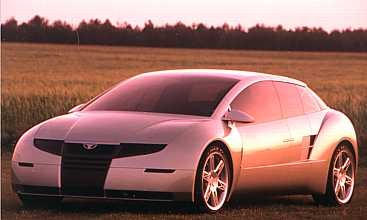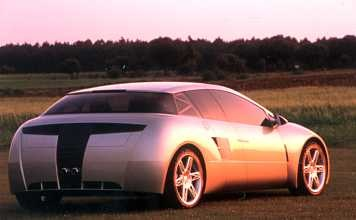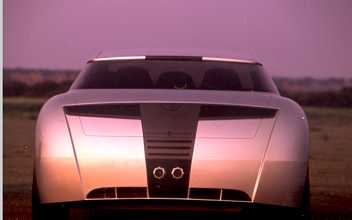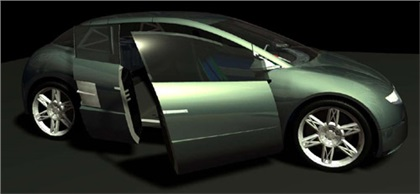1999 Daewoo Mirae
- Story Cars

- Oct 4, 2021
- 6 min read
The Ideas and Ethos Behind the Mirae
Concept cars have many roles. They allow a glimpse behind the scenes on future model programs, provide pointers to the aesthetic and technical ambitions of a manufacturer, and give a stimulus to the company's creative staff. Each thought has its specific reason for being. In the case of the Daewoo Mirae (Korean for "Future"), It's a glimpse into the future. Officially launched at the 1999 Seoul Motor Show, it explored the outer reaches of automotive technology in a car tilted for 2010 and to illustrate the positive attributes of a close working relationship between Korea and the United Kingdom via Daewoo's Worthing Technical Center.
Responding to the Daewoo design statement - "Designed Around You," the Mirae is the clear understanding of the balance between functional design and the aesthetic communication of the car's identity.
The car to take Daewoo into the future had to be an image-leading product to raise the company's profile and display the confidence of a fresh automotive brand. It had to also combine the fun and sophistication of a sportscar with enough space for a young family with sporting lifestyles.
Using a system of versatile/removable seating, maximum use of interior space was achieved. Tailoring the car to the user, making the system user-responsive, the interior could eliminate traditional switchgear, be reconfigured to taste, and use technologies that reduce environmental impact and maximize occupant safety while remaining affordable.
The Worthing Technical Center team developed this original concept under Design Director Ginger Ostle; The exterior was executed by Guy Colbourne, and the interior by Paul Wraith.
In being aimed at 2010, the Mirae could employ and seek to accommodate advanced development systems and communications technologies.
In many ways, an embodiment of the spirit that produced the radical thinking and aesthetics of the 1950s and 1960's GM show cars, the Mirae was the star of the 1999 Seoul Motor Show and the subject of much media interest. The "Norman helmet" graphics first executed here have been re-employed on subsequent Daewoo show vehicles, and the VSC concept has been further developed in the 2000 Daewoo Musiro show car. Its appeal would be broad, being altered from a single-seat supercar to a five-seat family car.
Exterior
The first and most important aspect of the Mirae exterior design is the fusion of the sports, family, and estate car elements into a single form. The brief was to satisfy the many various criteria of practicality and excitement whilst sticking to a relatively small overall length. The decision was taken early to mount the engine amidships and on its side to take advantage of a more user-focussed package. The rear load-bay is above the engine yet still low enough not to affect the sporty profile of the exterior or the usability of the luggage space. The wheels are pushed right out to the corners of the car, with minimal front and rear overhangs, to give the most interior space for the passengers.
From the front of the vehicle, the first and most striking feature is the grille's dark "T" graphic. A conscious decision was made to move away from the current Daewoo "Fan" chrome grille and produce something more fitting both for a sportscar and future 21st century Daewoo vehicles. The "T"-Graphic represents a Battle Helmet where the outer elements contain the headlights and the center and lower the front air intakes. The use of chrome for the grille was rejected in favor of Aluminium, Polycarbonate, and Teflon ( as these were felt to be more fitting for the new millennium). At the rear of the car, the graphic is repeated for the taillights, engine heat outlets, and exhausts. This produces greater visual drama than a standard grille giving the car a more purposeful and aggressive feeling whilst retaining the three elements that are the basis for the existing Daewoo grille and logo. The integration of the helmet "face" to the car gives a more coherent identity that is allied to clear functionality as well.
When looked at from above, the car has an arrowhead form created by the sweepback from the bumper to the front wheel arches. The enlarged rear wheel arch and sidestep feature echoes this. This gives the car a taught crouched feeling and shows that the cars' strength is at the rear, where the engine is. When viewed in profile, the step builds from the front wheel arch into the rear, adding to this direction. The side intakes are small so as not to detract from the overall feeling of simplicity.
The "designed around you" ethos shows through with the use of a bold, large glasshouse (most sportscars have a tight, claustrophobic feeling inside). It was felt that the car should echo the openness and functionality of the interior by wrapping the glass around the car from the A-pillar back. The front doors open in the normal way, but the rear doors are of a rearwards sliding "plug" design. The use of a sandwich floor structure allowed the removal of the normal B-pillar without affecting overall crash performance or strength and gave improved access for the driver and passengers. We also wanted to be able to load the vehicle from the side doors as well as the rear tailgate. The doors have no handles as such; there is an aluminum contact strip on each door that the driver touches whilst holding a "smartcard" transmitter to complete a low voltage circuit. The door then opens electrically. This greatly improves security as there are no standard locks to pick or radio "plipper" transmissions to scan.
The C pillar girder structure is visible through the glass, giving a link to the aesthetics and features of the interior. The wheel design contains another reference to the girder form giving a lightweight and dramatic yet visually simple 6-spoke 18in design. This girder idea is also taken up in the supports for the wing mirrors.
The car was given a hatchback profile at the rear as this allows the largest and most versatile load area. The rear tailgate is hinged both at the top and just below the glass, allowing it to "scissor" open. This makes it easier for shorter users to reach the tailgate (when it's open) to close it.
Finally, The lighting systems on the car are the very latest in HID (high-intensity Xenon gas discharge) and neon tube systems. These combine for greater lamp performance with greater durability and longevity.
Interior
The most striking thing about this interior is that you could be forgiven for thinking it doesn't have one. The mission to maximize interior space has removed a conventional instrument panel and center console by fully utilizing original technologies. The challenge was to package an MPV within a mid-engined supercar whilst inside and out the car was to be both practical and dramatic. The openness of the interior is punctuated by highly revolutionary minimal seating solutions. In order to extend the sense of spaciousness, the seats are of minimal section and unusually are translucent, allowing light to permeate to all interior areas. Each seat frame is independently actively sprung on four electronically-controlled theological spring units, the user setting the desired firmness while benefiting from anti-roll/pitch/submarine characteristics. Gel seating pads further cosset the occupant, heated and cooled to taste. Although the seats cannot be spun around on the spot through an original fixing method, the most flexible seat system perceived in recent years is possible.
When the Straight-6 engine is started, the seats clamp automatically to the floor; when the ignition is turned off, they disengage, allowing easy movement via rollers on the flat sandwich floor forward and back, side to side, and even diagonally, located in "cups" on the floor. Seats can be removed without detriment to interior aesthetic; the car purchased empty and specified according to owner need. Each seat is fitted with 4-point retractable seat belts for maximum occupant safety, reflecting Mirae's sporting intent. The steering, brakes, and accelerator are electronic. With no mechanical connection, the steering and pedals can be moved independently. In Mirae, the control unit is movable side to side; offering left and right and central driving positions. The instrument panel is deleted altogether, with conventional manual controls replaced by voice and gestural activated alternatives. Ancillary components from this area are housed within the sandwich floor. Opening up this area further increases the sense of interior volume and is utilized for storage when required.
The boot area is separated from the occupant space via a sliding glass partition which helps lower cabin noise and contains luggage in transit. If required, this can be lowered, and the movable boot floor (when rear seats are removed) slid forwards, providing room for mountain bikes; when slid backward, it allows more effortless loading. The Mirae, although as long as a Toyota MR-2 (strictly a two-seat, one-bag sportscar), has the luggage space of an estate car.
Source: conceptcar.co.uk - Daewoo Design; Daewoo; www.dweb.hu/daewoofanpage

%20(4)_edited.png)





















































Comments